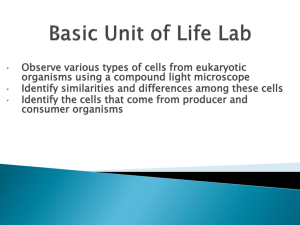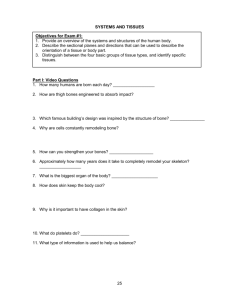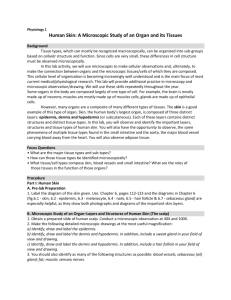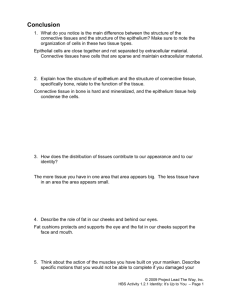Body Tissues eLab
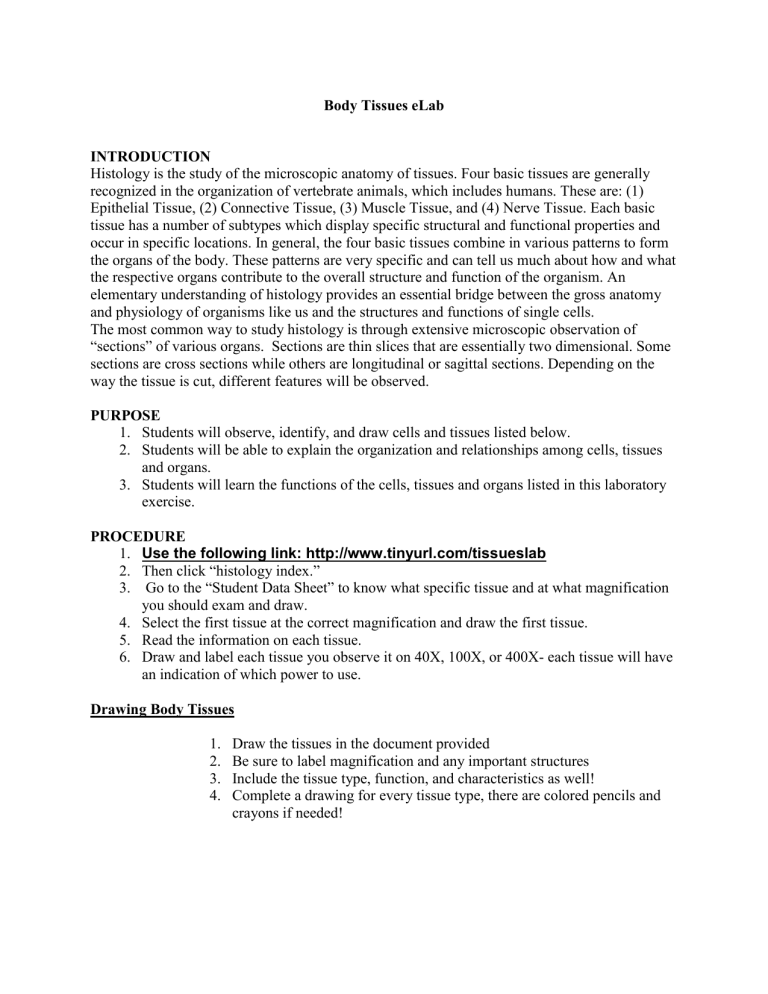
Body Tissues eLab
INTRODUCTION
Histology is the study of the microscopic anatomy of tissues. Four basic tissues are generally recognized in the organization of vertebrate animals, which includes humans. These are: (1)
Epithelial Tissue, (2) Connective Tissue, (3) Muscle Tissue, and (4) Nerve Tissue. Each basic tissue has a number of subtypes which display specific structural and functional properties and occur in specific locations. In general, the four basic tissues combine in various patterns to form the organs of the body. These patterns are very specific and can tell us much about how and what the respective organs contribute to the overall structure and function of the organism. An elementary understanding of histology provides an essential bridge between the gross anatomy and physiology of organisms like us and the structures and functions of single cells.
The most common way to study histology is through extensive microscopic observation of
“sections” of various organs. Sections are thin slices that are essentially two dimensional. Some sections are cross sections while others are longitudinal or sagittal sections. Depending on the way the tissue is cut, different features will be observed.
PURPOSE
1.
Students will observe, identify, and draw cells and tissues listed below.
2.
Students will be able to explain the organization and relationships among cells, tissues and organs.
3.
Students will learn the functions of the cells, tissues and organs listed in this laboratory exercise.
PROCEDURE
1.
Use the following link: http://www.tinyurl.com/tissueslab
2.
Then click “histology index.”
3.
Go to the “Student Data Sheet” to know what specific tissue and at what magnification you should exam and draw.
4.
Select the first tissue at the correct magnification and draw the first tissue.
5.
Read the information on each tissue.
6.
Draw and label each tissue you observe it on 40X, 100X, or 400X- each tissue will have an indication of which power to use.
Drawing Body Tissues
1.
Draw the tissues in the document provided
2.
Be sure to label magnification and any important structures
3.
Include the tissue type, function, and characteristics as well!
4.
Complete a drawing for every tissue type, there are colored pencils and crayons if needed!
STUDENT DATA SHEET Name:________________________
OBSERVATIONS
Draw and label
(make sure to click the labels “on”) each tissue you observe on your drawing paper provided.
Please view each tissue type in 40X, 100X, 400X, and 100X when available. Use the following as a guideline to sketch each tissue type. Please read the information found with each power viewing of each tissue type.
You will need to answer analysis questions during and after viewing and drawing each tissue type.
*Remember to include 4 drawings per page!
1. Simple Squamous Epithelium 100X
2. Simple Cuboidal Epithelium 400X
3. Simple Columnar Epithelium 400X
4. Stratified Squamous Epithelium 400X
5. Bone, compact 100X
6. Elastic cartilage 100X
7. Fibrocartilage 100X
8. Adipose Tissue 100X (click on Sudan IV to draw)
9. Areolar Tissue 400x
10. Reticular Tissue 100X (click reticular- 100x to draw with collagen fibers)
11. Dense Regular Connective tissue 40X
12. Blood 400X
13. Skeletal Muscle 1000X
14. Smooth Muscle 400X
15. Cardiac Muscle 1000X
16. Nerve (ls) 100X
ANALYSIS
Answer each question in complete sentences.
1.
What magnification shows the best overall view of the tissue? Which shows the most detail?
2.
What is the difference between squamous and stratified epithelium?
3.
What are the dark black specks on the bone tissue slide?
4.
What is the name of the canal within the bone tissue that allows blood vessels to pass?
5.
What makes the identification of elastic cartilage easy?
6.
What are the two identifying characteristics of fibrocartilage?
7.
What is contained within an adipose cell?
8.
Why is the nucleus of an adipose cell not always visible (400X)?
9.
What types of cells are found within areolar connective tissue?
10.
How is dense connective tissue recognizable?
11.
What do the bands create in skeletal muscle?
12.
How is smooth muscle different from dense connective tissue?
13.
What are the cell-to-cell junctions called in cardiac muscle?
14.
How is smooth muscle different from cardiac and skeletal?
15.
What are the dark lines in the nerve tissue?
16.
Explain the relationship among cells, tissues, and organs.
